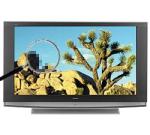
At this year's CEDIA Expo, an industry trade show devoted to home audio, video, and distributed A/V products, I saw the same recurring theme at every TV manufacturer's booth... 1080p is a reality. TV makers will be releasing tons of new 1080p fixed pixel TV sets into the marketplace in the very near future. In fact, many of these new TVs can be purchased right now at your local retailer. While discussing the fine points of the show with colleagues and interested parties, I get hit with the same statement over and over again, "Why should I care about 1080p when the maximum TV resolution is 1080i." While that statement is true, it's apparently clear that few consumers (and even the tech savvy) really get why this is an important leap for television technology.
Fixed Pixel Products Today
It's been said by industry experts and videophiles for the last 3 years... fixed pixel displays like DLP, LCD, Plasma, LCoS, D-ILA, etc. do not match CRT projection TVs in terms of picture quality. Sure, they're thinner, brighter, weigh a heck of a lot less, and are even sometimes sharper, but the resolution and black levels have always suffered compared to the thick, bulky CRT sets. Black level and resolution are extremely important for optimum image quality.
Black level will remain an issue for fixed pixel displays in the short term, but the resolution gap will soon be gone. In fact, the bump to 1080p will actually give fixed pixel displays a resolution advantage over CRT projection displays, which until now has always been the opposite. It wouldn't be fair to say that all fixed pixel TVs before today are 720p products. Some LCoS projection TVs have been 1080p for years, but the price points have been so high that very few units were ever sold.
Why Does 1080p Matter When TV Tops Out at 1080i?
The ATSC standard allows for two entirely different resolutions to be considered "high-definition". One of these resolutions is the 720p format, which as an actual resolution of 720x1280 in a progressive format. Progressive means that each field contains a complete picture. The 1080i format has an actual resolution of 1080x1920 (over two times the image density), in an interlaced format. Interlaced means that each complete frame is divided between two fields, one with all the odd numbered lines (line 1, 3, 5, 7, etc.) and the other with all the even (2, 4, 6, 8, etc.). When played back at 60 cycles per second, it looks like a complete 1080x1920 picture.
To keep it simple, nearly all past generation fixed pixel product has a native resolution at or near 720p. This means that any resolution less than 720x1280 won't take up the entire screen, so these images must be digitally processed so they fit a 720x1280 space. Processing signals up sometimes adds digital artifacts and other picture anomalies.
The same is true for images of higher resolution, except going down reduces the image density of the picture. Simply put, 720x1280 native TVs can display 921,600 pixels in the correct shape. A complete 1080i signal has 2,073,600 pixels. Even a single field of an interlaced 1080i picture has more image density than an entire 720p frame. In order to properly display a 1080i signal on a 720p TV, 1,152,000 pixels must be eliminated to properly fit. That's right, CSI: and all other 1080i broadcasts look half as good as they should on a 720p TV.
A native 1080p TV will still have to process signals lower than 1080p, but it will not have to reduce image quality on any signal it receives (at least for the forseeable future). A 1080i signal will need to be processed before it can be displayed as a progressive signal, but the resolution will not have to be reduced.
Actual 1080p Sources Coming Soon!
Don't think for a second that 1080i sources will be the top signal you can receive; there are many 1080p sources on the way. Blu-Ray the format for commercially available HD movies, are both capable of outputting a 1080p signal if the studio releases the movie that way. A movie at 1080p has well over 10 times the image density of a DVD. HD-DVD used to be a competitor to Blu-Ray for domincance as the next gen format, but was abandoned by Toshiba in February of 2008 after Warner and several retailers stopped backing the format.
Video games will also give your 1080p TV something to take advantage of every pixel available. Sony's PlayStation 3 is said to be able to support two 1080p monitors at once on supported titles. Microsoft has said that all XBOX 360 games will be high-definition, and 1080p is an option to developers. Video games will never look the same. 1080p may not just be limited to movies and games either. Though 1080p not a part of the official broadcast standard, there is nothing stopping cable and satellite companies from providing 1080p solutions for thier consumers... other than the money...
Conclusion
The move to 1080p TVs will not be an overnight switch; 720p products will still be around for a few more years. However, going forward, these products will sell for a lower price than the 1080p variety, bringing these newer technologies in the price range of nearly all consumers. It's important to remember that the difference between 720p and 1080p TVs will not be obvious at resolutions lower than 720p, but anything higher will show better on a 1080p display.




